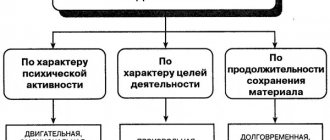Characteristics of attention. Types of attention
A limited amount of attention determines its main characteristics: stability, concentration, distribution, switchability and objectivity.
Sustainability
- this is the duration of attracting attention to the same object or to the same task. It can be determined by peripheral and central factors. Stability, determined by peripheral factors, does not exceed 2-3 seconds, after which attention begins to fluctuate. The stability of central attention can span a significantly longer interval – up to several minutes. It is clear that fluctuations in peripheral attention are not excluded; it returns all the time to the same object. At the same time, the duration of attracting central attention, according to S. L. Rubinstein, depends on the ability to constantly reveal new content in an object. We can say that the more interesting an object is for us, the more stable our attention will be. Sustainability of attention is closely related to its concentration.
Concentration
is determined by the unity of two important factors - an increase in signal intensity with a limited field of perception.
Under distribution
understand the subjectively experienced ability of a person to hold a certain number of heterogeneous objects in the center of attention at the same time. It is this quality that makes it possible to perform several actions at once, keeping them in the field of attention. Many have heard about the phenomenal abilities of Julius Caesar, who, according to legend, could do seven unrelated things at the same time. It is also known that Napoleon could simultaneously dictate seven important diplomatic documents to his secretaries. However, there is every reason to assume that only one type of conscious mental activity occurs at the same time, and the subjective feeling of the simultaneous performance of several is due to a rapid sequential switching from one to another. Thus, the distribution of attention is essentially the reverse side of its switching.
Switchability
determined by the speed of transition from one type of activity to another. The important role of this characteristic is easy to demonstrate when analyzing such a well-known and widespread phenomenon as dissipation, which boils down mainly to poor switchability.
Types of human memory by sense organs
Figurative
This memory is responsible for remembering sights, smells, tastes and sounds. It is not difficult to guess which sense organs are developed in artists, sommeliers, chefs and musicians. However, figurative memory is quite easy to develop because we always have training tools at hand.
Verbal-logical
This is remembering and reproducing our thoughts. We also remember the content of a film, a conversation, a song.
Memory is not simply called verbal-logical. This type of memory manifests itself in three cases:
- Only the meaning of the information is remembered.
- Not only the meaning of information is remembered, but also the literal verbal expression of thoughts.
- The literal verbal expression of thoughts is remembered, but not the meaning.
Surely it has happened to everyone when we memorized a text word for word, but could not retell it in our own words. Or they didn’t remember the text, but could reproduce the essence.
Motor
This memory plays a key role for athletes and people who, as part of their profession, must remember a certain sequence of movements. For example, actors not only learn to get used to the role in order to look truthful on stage, but also sign up for dances - the more developed the motor memory, the easier it is to improvise and perform non-standard movements.
Emotional
This memory is associated with experiences, both positive and negative. With its help, both phobias and the level of happiness are formed. The higher the emotional intensity, the better a person will remember the experience. This memory is often used to learn foreign words, trying to emotionally “attach” one’s experiences to the word being studied.
Types of attention
free
- consciously regulated, focused on the object.
Involuntary
- does not arise on purpose, but under the influence of the characteristics of objects and phenomena, such attention allows you to navigate changes in the environment.
Post-voluntary
– arises consciously after the voluntary and does not require effort in order not to be distracted.
In the process of perception, with appropriate attention, a person creates subjective images of objective objects and phenomena that directly affect his sensory organs. Some of these images arise and change during sensations and perceptions. But there are images that remain after the cessation of sensations and perceptions or when these processes switch to other objects. Such images are called representations.
12 pages, 5739 words
The influence of temperament on human activity and behavior
... activities by the characteristics of the individual’s inner world, the focus of processes on oneself. The opposite is extraversion (objectification), in which the main thing for the individual is the objects of the external world (objects and other people) ... - regulation of the dynamics of mental activity as a whole; — characteristics of the dynamics of individual mental processes; - stability of character throughout...
Ideas and their connections (associations) can persist in a person for a long time. Unlike images of perception, ideas are caused by images of memory.
Properties of attention
The properties of attention—direction, volume, distribution, concentration, intensity, stability and switchability—are associated with the structure of human activity. At the initial stage of activity, during the implementation of general orientation, when the objects of this environment are still equally significant, the main feature of attention is breadth, an evenly distributed focus of consciousness on several objects. At this stage of activity there is still no stability of attention. But this quality becomes significant when the most significant ones for a given activity are identified from the available objects. Mental processes are concentrated on these objects.
Depending on the significance of the activity, mental processes become more intense. The duration of action necessitates the stability of mental processes.
The span of attention is the number of objects that a person can simultaneously be aware of with the same degree of clarity.
If an observer is shown a number of objects simultaneously for a short period of time, it turns out that people cover four or five objects with their attention. The amount of attention depends on a person’s professional activity, his experience, and mental development. The amount of attention increases significantly if objects are grouped and systematized.
During interrogation, it should be taken into account that a witness who perceived an event during a short period of time (for example, a criminal quickly running away for cover, a car rushing at high speed) cannot testify about more than four or five features of the perceived objects.
The volume of attention is somewhat less than the volume of awareness, because along with the clear reflection of objects in our consciousness at each moment there also occurs an indistinct awareness of many other objects (up to several dozen).
Distribution of attention is the focus of consciousness on performing several simultaneous actions. Thus, while conducting a search, the investigator simultaneously examines the premises, maintains contact with the person being searched, observes the slightest changes in his mental state, and makes assumptions about the most likely places where the objects being sought are stored. The distribution of attention depends on experience, skills and abilities. A novice driver tensely regulates the movement of the car, he can hardly take his eyes off the road to look at the instruments, and is in no way inclined to carry on a conversation with his interlocutor. It is very difficult for a novice cyclist to simultaneously move the pedals, maintain balance and monitor the features of the road. Having acquired the appropriate stable skills during the exercise, a person begins to perform certain actions semi-automatically: they are regulated by those parts of the brain that are not in a state of optimal arousal. This makes it possible to perform several actions simultaneously, while any new action requires complete concentration of consciousness.
4 pp., 1980 words
Technologies of socio-cultural activities with older people
... development of a draft program for organizing social and cultural activities of older people. Object of study: the process of organizing socio-cultural activities with older people. Subject of research: technologies of socio-cultural activities with older people. Research hypothesis: organization...
Concentration of attention is the degree of concentration of consciousness on one object, the intensity of the focus of consciousness on this object.
Switchability of attention is the speed of voluntary change of objects of mental processes. This quality of attention largely depends on the individual characteristics of a person’s higher nervous activity—the balance and mobility of nervous processes. Depending on the type of higher nervous activity, the attention of some people is more mobile, others - less mobile. This individual feature of attention should be taken into account during professional selection. High switchability of attention is a necessary quality of an investigator. Frequent shifts of attention present significant mental difficulties, cause overwork of the central nervous system,
Sustainability of attention is the duration of concentration of mental processes on one object. It depends on the significance of the object, on the nature of the actions with it and on the individual characteristics of the person.
Imagination is a mental cognitive process of creating new ideas based on existing experience, i.e. the process of transformative reflection of reality. Considering the characteristics and causes of occurrence, several types of imagination are distinguished. Involuntary (passive, unintentional) imagination is the creation of new images without any external stimuli. Voluntary (active, intentional) imagination - the creation of new images through volitional efforts. It represents the deliberate construction of images in connection with a consciously set task in one or another type of activity. A dream is an image of a desired future. The images that a person creates in his dreams are distinguished by the following features: a) bright, lively, concrete character, with many details and particulars; b) weak expression of specific ways to realize a dream, imagination of these ways and means in the most general terms (in the form of a certain tendency); c) the emotional richness of the image, its attractiveness to the dreaming individual; d) the desire to combine dreams with a feeling of confidence in its feasibility, with a passionate desire to turn it into reality. 4. Creative imagination is the creation of new images in the process of human creative activity (in art, science, etc.). 5. Recreative (reproductive) imagination is imagination based on what is read or heard.
Examples of similar educational works
Question 1. Memory as a mental function and process
... that is, any manifestation of human life is an object of memorization. This process is the first in the chain of mnemonic processes - it is necessary for any subsequent manifestation of memory. Memorization can be mechanical or...
Memory as a reproductive and productive process
... these actions. The function of consolidating connections is not performed by repetition, but by the act of correct reproduction of an object, the correspondence of the reproduced image to the object of memorization. Chapter 1. Theoretical part. Memory problems in works...
Psychological aspects of perception, memorization and reproduction of information about signs...
... The object of the study was the psychological aspects of perception, memorization and reproduction of information about the signs of a person’s appearance, the possibility of retrieving such information from memory ... operational activities. Relevance... to criminal proceedings. ...
The child as an object and subject of the pedagogical process
... directed influence of society on the formation of personality); a person's own practical activity. In this context, a factor is considered as the driving force of the development process, and a condition is considered as a circumstance on which ...
The structure of the activities of a higher school teacher in the educational process
... the process as a whole. .Determine the structure of a teacher’s activity in a higher educational institution. The object of the study is the structure of activity... - a combination of a scientist and a teacher - a person of highest qualification, a real tribune. Second category...
Memory, its processes, properties, types
Everything that a person once perceived does not disappear without a trace - traces of the excitation process are preserved in the cerebral cortex, which create the possibility of re-occurrence of excitation in the absence of the stimulus that caused it. Thanks to this, a person can remember and save, and subsequently reproduce the image of a missing object or reproduce previously acquired knowledge. Like perception, memory is a process of reflection, but in this case not only what is immediately active is reflected, but also what took place in the past.
Memory is a special form of reflection, one of the main mental processes aimed at consolidating mental phenomena in the physiological code, preserving them in this form and reproducing them in the form of subjective ideas.
In the cognitive sphere, memory occupies a special place; without it, knowledge of the world around us is impossible. The activity of memory is necessary when solving any cognitive problem, since memory underlies any mental phenomenon and connects a person’s past with his present and future. Without including memory in the act of cognition, all sensations and perceptions will be perceived as having arisen for the first time and comprehension of the surrounding world will become impossible.
Physiological basis of memory.
Memory is based on the property of nervous tissue to change under the influence of a stimulus and to retain traces of nervous excitation. The strength of the traces depends on what kind of traces took place. At the first stage, immediately after exposure to the stimulus, short-term electrochemical reactions occur in the brain, causing reversible physiological changes in cells. This stage lasts from several seconds to several minutes and is a physiological mechanism of short-term memory - there are traces, but they have not yet been consolidated. At the second stage, a biochemical reaction occurs associated with the formation of new protein substances, which leads to irreversible chemical changes in cells. This is a mechanism of long-term memory - traces are strengthened and can exist for a long time.
In order for information to be stored in memory, some time is necessary, the so-called time of consolidation, strengthening of traces. A person experiences this process as an echo of an event that has just happened: for some time he continues to see, hear, feel something that he no longer directly perceives (“stands before his eyes,” “sounds in his ears,” etc.). Consolidation time – 15 min.
Temporary loss of consciousness in people leads to forgetting what happened in the period immediately preceding this event - anterograde amnesia occurs - a temporary inability of the brain to record traces. Objects or phenomena that are connected in reality are also connected in human memory. To remember something means to connect the memorization with what is already known, to form an association. Consequently, the physiological basis of memory is also the formation and functioning of a temporary neural connection (association) between individual links of what was previously perceived. There are two types of associations: simple and complex.
Three types of associations are considered simple:
1) by contiguity - two phenomena connected in time or space are combined (Chuk and Gek, Prince and Pauper, alphabet, multiplication table, arrangement of pieces on a chessboard);
2) by similarity - phenomena that have similar features are associated (willow - a woman in the mountain, “cherry blizzard”, poplar fluff - snow;
3) by contrast - they connect two opposite phenomena (winter - summer, black - white, heat - cold, health - illness, sociability - isolation, etc.).
Complex (semantic) associations are the basis of our knowledge, since they connect phenomena that in reality are constantly connected:
1) part - whole (tree - branch, hand - finger);
2) genus – species (animal – mammal – cow);
3) cause – effect (smoking in bed leads to a fire);
4) functional connections (fish - water, bird - sky, air).
For the formation of a temporary connection, a repeated coincidence of two stimuli in time is required, i.e., repetition is required for the formation of associations. Another important condition for the formation of associations is business reinforcement, i.e., the inclusion of what needs to be remembered in the activity.
Memory processes.
Memory includes several interrelated processes: remembering, storing, forgetting and reproducing.
Memorization is a process aimed at retaining received impressions in memory by associating them with existing experience. From a physiological point of view, memorization is the formation and consolidation in the brain of traces of excitation from the influence of the surrounding world (things, drawings, thoughts, words, etc.). The nature of memorization, its strength, brightness, clarity depend on the characteristics of the stimulus, the nature of the activity, and the mental state of the person. The process of memorization can occur in three forms: imprinting, involuntary and voluntary memorization.
Capture (imprinting) is a durable and accurate storage of events as a result of a single presentation of material for a few seconds. The state of imprinting—instant imprinting—occurs in a person at the moment of the highest emotional stress (eidetic images).
Involuntary memorization occurs in the absence of a conscious intention to remember with repeated repetition of the same stimulus, is selective in nature and depends on a person’s actions, i.e., it is determined by motives, goals, and emotional attitude to the activity. Something unusual, interesting, emotionally exciting, unexpected, bright is unintentionally remembered.
Voluntary memorization is the leading form in humans. It arose in the process of work and is caused by the need to preserve knowledge, skills and abilities, without which work is impossible. This is a higher level of memorization with a pre-set goal and the application of volitional efforts.
For greater efficiency of voluntary memorization, the following conditions must be met:
— the presence of a psychological attitude towards memorization;
— understanding the meaning of acquired knowledge;
- self-control, a combination of memorization and reproduction;
- reliance on rational memorization techniques.
Rational methods of memorization (mnemonic methods) include highlighting strong points, semantic grouping of material, highlighting the main thing, drawing up a plan, etc.
A type of voluntary memorization is memorization - systematic, planned, specially organized memorization using mnemonic techniques.
According to the result, memorization can be verbatim, close to the text, semantic, requiring mental processing of the material, according to the method - in general, in parts, combined. According to the nature of the connections, memorization is divided into mechanical and logical (semantic), the effectiveness of which is 20 times higher than mechanical. Logical memorization involves a certain organization of material, understanding the meaning, connections between parts of the material, understanding the meaning of each word and the use of figurative memorization techniques (diagrams, graphs, pictures).
The main conditions for lasting memorization are:
— awareness of the goal, task;
— the presence of a memorization setting;
- rational repetition - active and distributed, since it is more effective than passive and continuous.
Retention is the process of more or less long-term retention in memory of information obtained through experience. From a physiological point of view, preservation is the existence of traces in a latent form. This is not a passive process of retaining information, but a process of active processing, systematization, generalization of material, and mastery of it.
Conservation primarily depends on:
- from personality attitudes;
— the force of influence of the memorized material;
— interest in the reflected impacts;
- human condition. With fatigue, a weakened nervous system, or a serious illness, forgetting manifests itself very sharply. Thus, it is known that Walter Scott wrote “Ivanhoe” during a serious illness. Reading the work after recovery, he could not remember when or how he wrote it.
The process of preservation has two sides - actual preservation and forgetting.
Forgetting is a natural process of extinction, elimination, erasing traces, and inhibiting connections. It is selective in nature: what is forgotten is what is not important for a person and does not correspond to his needs. Forgetting is an expedient, natural and necessary process that gives the brain the opportunity to free itself from excess unnecessary information.
Forgetting can be complete - the material is not only not reproduced, but also not recognized; partial - a person recognizes the material, but cannot reproduce it or reproduces it with errors; temporary - when nerve connections are inhibited, complete - when they fade.
The process of forgetting proceeds unevenly: at first quickly, then slows down. The highest percentage of forgetting occurs in the first 48 hours after memorization, and this continues for another three days. Over the next five days, forgetting progresses more slowly.
This leads to the following conclusion:
- the material must be repeated a short time after memorization (the first repetition is after 40 minutes), since after an hour only 50% of the mechanically memorized information remains in the memory;
- it is necessary to distribute repetitions over time - it is better to repeat the material in small portions once every 10 days than three days before the exam;
- understanding and comprehension of information is necessary;
— to reduce forgetting, it is necessary to include knowledge in activities.
The reasons for forgetting can be either non-repetition of the material (fading connections) or repeated repetition, during which extreme inhibition occurs in the cerebral cortex.
Forgetting depends on the nature of the activity that precedes memorization and occurs after it. The negative influence of the activity preceding memorization is called proactive inhibition, and the activity following memorization is called retroactive inhibition, which occurs in cases when, after memorization, an activity similar to it or requiring significant effort is performed.
The material stored in memory changes qualitatively, is reconstructed, traces become paler, bright colors fade, but not always: sometimes later, delayed reproduction turns out to be more complete and accurate than earlier. This improved delayed reproduction, characteristic primarily of children, is called reminiscence.
Reproduction is the most active, creative process, which consists in recreating in activity and communication the material stored in memory. There are the following forms: recognition, involuntary reproduction, voluntary reproduction, recollection and recollection.
Recognition is the perception of an object in conditions of its repeated perception, which occurs due to the presence of a weak trace in the cerebral cortex. It's easier to learn than to reproduce. Out of 50 objects, a person recognizes 35.
Involuntary reproduction is reproduction that occurs as if “by itself.” There are also obsessive forms of reproducing any representation of memory, movement, speech, which are called perseveration (from the Latin I persist). The physiological mechanism of perseveration is the inertia of the excitation process in the cerebral cortex, the so-called “stagnant focus of excitation.” Perseveration can occur in a completely healthy person, but is more often observed during fatigue and oxygen deprivation. Sometimes an obsession, a thought (idefix) becomes a symptom of a neuropsychic disorder - neurosis.
Voluntary reproduction is reproduction with a pre-set goal, awareness of the task, and effort.
Recall is an active form of reproduction associated with tension, requiring volitional effort and special techniques - association, reliance on recognition. Recall depends on the clarity of the tasks and the logical ordering of the material.
Memory is the reproduction of images in the absence of perception of the object, “historical memory of the individual.”
Types of memory.
There are several types of memory based on various criteria.
1. According to the nature of mental activity that predominates in activity, memory can be figurative, emotional and verbal-logical.
Figurative memory includes visual, auditory, eidetic memory (a rare type of memory that retains a vivid image for a long time with all the details of what is perceived, which is a consequence of the inertia of excitation of the cortical end of the visual or auditory analyzers); olfactory, tactile, gustatory and motor, or motor (a special subtype of figurative memory, consisting of memorizing, storing and reproducing various movements and their systems). Motor memory is the basis for the formation of practical, labor and sports skills. Figurative memory is inherent in both animals and people.
Emotional memory is the memory of feelings and emotional states, which, when experienced and stored in consciousness, act as signals either encouraging action or restraining from actions that caused negative experiences in the past. The ability to sympathize and empathize is based on emotional memory, since it regulates human behavior depending on previously experienced feelings. Lack of emotional memory leads to emotional dullness. In animals, what caused pain, anger, fear, rage is remembered faster and allows them to avoid similar situations in the future.
Verbal-logical (semantic, symbolic) memory is based on the establishment and memorization of semantic concepts, formulations, ideas, sayings. This is a specifically human type of memory.
2. Based on the degree of volitional regulation, the presence or absence of a goal and special mnemonic actions, a distinction is made between involuntary memory , when information is remembered by itself - without setting a goal, without effort, and voluntary memory , in which memorization is carried out purposefully using special techniques.
3. The duration of retention of material is distinguished between short-term, long-term and operational memory.
Long-term memory is the main type of memory that ensures long-term preservation of what is imprinted (sometimes for a lifetime). Long-term memory is of two types: open access, when a person can voluntarily retrieve the necessary information, and closed, access to which is possible only under hypnosis. With short-term memory, material is stored for up to 15 minutes. Working memory involves retaining intermediate materials in memory as long as a person deals with them.
Properties (quality) of memory.
These include:
- speed of memorization - the number of repetitions required to retain the material in memory;
- rate of forgetting - the time during which the material is stored in memory;
- the memory capacity for completely new material and material that does not make sense is equal to “Miller's magic number” (7 ± 2), indicating the number of units of information held in memory;
— accuracy – the ability to reproduce information without distortion;
- mobilization readiness - the ability to recall the right material at the right time.
Memory develops through exercise and hard work on memorization, long-term preservation, complete and accurate reproduction. The more a person knows, the easier it is for him to remember new things, linking and associating new material with what is already known. With a general decline in memory with age, the level of professional memory does not decrease, and sometimes can even increase. All this allows us to draw the following conclusion: memory as a mental phenomenon is not only a gift of nature, but also the result of targeted upbringing.









